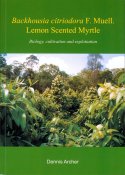
Book
Reviews
Book 23

Backhousia citriodora F. Muell Lemon Scented Myrtle -Biology, Cultivation & Exploitation by Dennis Archer pub. 2004 by Toona Essential Oils Pty. Ltd. ISBN 0 9751845-0-4
Dennis Archer has used his knowledge and experience of
raising Australian aromatic plants and the Australian essential oil trade, to
produce an informative and attractive 87 page book, well illustrated with
photographic shots of the subject matter. The
book is authoritative and presents an overview of the position of the oil in
relation to the history of the Australian oils industry, and the potential of
the oil for end-user applications today.
Chapter subjects include the history of Backhousia
citriodora, the Biology, Silviculture, Exploitation and Research, with
appendices covering safety and handling of the oil. With a more critical eye, it
is hard to fault much of the contents – the chapter on the history of the
plant for example is well researched and comprehensive, going back to the first
literature mention of Shimmel &
Co. of Dresden in 1888. The chapter on biology covers the morphological aspects
of the tree, foliage, flowers and seeds, wood and plant genetics generally.
Chemotypes are also mentioned - variety “A” – first mentioned in 1950 and
rediscovered in 1996 - being particularly rich in laevo-citronellal at
the expense of the citral content.
The 21-page, lavishly illustrated silviculture chapter,
gives way to a chapter on Exploitation which is perhaps from the reviewers point
of view, is amongst the most interesting parts of the book. A thorough account
of harvesting follows a discussion of the analysis of the commercially available
oils - the composition of the normal oil (as distinct from the laevo-citronellal
type) revealing a high citral content. A chapter on research (applications) and
a concluding page complete the text.
In general terms it is a pleasure to see such a
specialist area being so well covered in such a competent manner. If I had any
criticisms at all of the publication, it would be to include more on potential
applications - suggestions for uses in perfumery & natural perfumery (as
either a modifier or dominant ingredient for citrus top notes, airfreshner
perfumes etc.) - and to cover more fully the potential microbiological
applications. The fact that citral is an irritant and an allergen (see 7th
Amendment to the EU Cosmetics Act) and binds to dermal proteins, may of course
limit its potential applications in mainstream skin perfumes, and in
aromatherapy massage. But for non-skin and biocidal applications, the oil of Backhousia
citriodora has some interesting properties which may justify its’ extra
cost over other high citral-containing oils such as Litsea cubeba –
again something not quite fully bought out in the text.
Nevertheless, I would sincerely recommend this publication for a place in the serious essential oil user’s library.